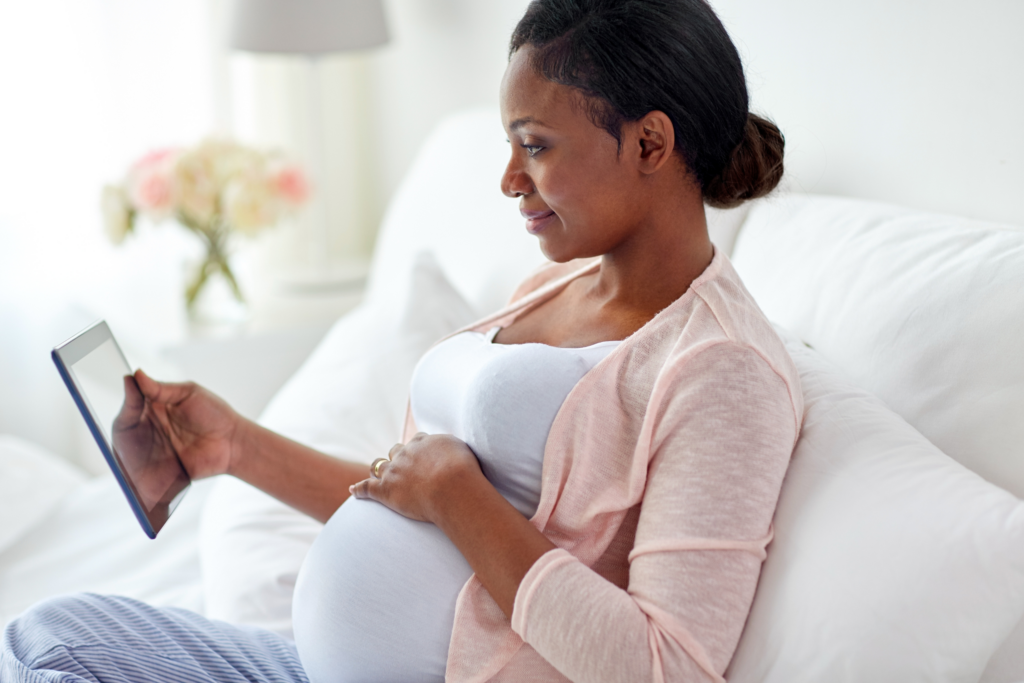With the advancement of medical technology, childbirth has become a much safer experience for parents worldwide. Whether you’ve planned for a natural birth, medically induced birth, or C-section, these plans can be subject to last-minute changes.
It’s a busy time filled with preparation, apprehension, and excitement for both parents in the run-up to their due date. So, it’s best to be versed in all types of delivery methods so you’re prepared for whatever comes your way when the time comes. Keep reading to learn about the most common types of delivery!
*Please note that this is not a comprehensive list, and we do not provide medical advice.

Types of Delivery for Pregnancy
1. Natural Birth (Vaginal Birth)
Natural birth, also known as unmedicated vaginal birth, involves birthing your baby without pain relief, induction, or other medical assistance. Many parents choose natural birthing because of the possible benefits, which include:
- Increased mobility – without epidurals or pain medication, the parent can move around and use items such as exercise balls during labor.
- Reduced risks of side effects: epidurals are frequently used in childbirth to relieve pain by providing a local anesthetic to the lower half of your body. Epidurals stop the pain and can also numb feelings from the waist down, meaning the mother doesn’t feel the pain of childbirth. However, there are possible side effects such as headaches, nausea, difficulty passing urine, and pain for a few days afterward.
- Better gut health for your baby: when a baby is delivered vaginally, the baby comes into contact with bacteria from their mother’s gut. This means the baby absorbs the mother’s microbiome, creating essential gut bacteria in the baby’s intestines.
Natural birth can occur in a hospital; this can be beneficial to have medical assistance if necessary. You can also give birth to a baby naturally at home with the assistance of a birthing coach or doula. This is preferable for some parents due to the familiarity and comforts at home.
2. Induced Labor
Induced labor can occur from 37 to 42 weeks of pregnancy. The labor is artificially induced by mechanically opening the cervix or using medications to induce contractions and birth. Induced labor can sometimes be more painful than natural labor because contractions come strong and fast. This type of delivery is typically used when the baby is overdue (more than 41 weeks).
3. Vacuum Extraction
Vacuum extraction is one of the types of delivery using assisted delivery techniques that occurs when vaginal delivery has stalled for some time. In this case, it’s important to ensure the baby keeps moving safely and is guided out of the birth canal. To do this, a doctor will use a suction cup device that attaches to the baby’s head and gently guides the baby out.
This technique is used to guide the baby out of the birth canal and vagina. Vacuum extraction is executed when the baby is stuck in the birth canal and isn’t moving out of the vagina. Or, the mother can be too tired to continue pushing. Also, if there’s a risk that the baby isn’t receiving enough oxygen, the doctor can decide to perform a vacuum extraction. This technique is extremely safe and effective in assisting the mother’s well-being and the delivery of a happy baby.
4. Forceps Assisted Delivery
Forceps-assisted delivery involves assisting the birth using a medical tool shaped like metal tongs. The doctor will use the device to gently grasp a baby inside the birth canal and help guide them out. This delivery method isn’t very common but can be helpful in certain circumstances to avoid C-sections.
For example, forceps are used when labor has stalled in the pushing stage. That is, Mom could have been pushing for several hours, but there’s still no sign of her baby showing. When labor stalls, there can be health risks, such as abnormal heart rate patterns that indicate the baby isn’t receiving enough oxygen. Doctors will act instinctively to help your baby exit the birth canal safely; this is when a forceps-assisted delivery is helpful.

5. Cesarean Birth (C-Section)
Cesarean birth, also known as C-section, is a form of birth involving a surgical procedure when the baby is removed from the womb. This procedure can be planned from the beginning of pregnancy or occur as an emergency or unplanned procedure at a later stage when a vaginal birth is no longer an option.
Planned (Scheduled) Caesarean
A planned Caesarean is known as an elective Caesarean. C-sections are extremely common and can be the safest option for your childbirth experience. A doctor can recommend a C-section at any time throughout the pregnancy, and the mother will often have ample time to prepare for this procedure. Your doctor may recommend a C-section if:
- Your baby isn’t moving into a head-down position for a vaginal birth
- Your baby is too large for a vaginal birth
- You have pregnancy-related high blood pressure, or a low-lying placenta
Unplanned C-section
Unplanned C-sections can occur during the last few weeks, days, or even hours before your delivery. Although you may have decided on a vaginal birth, your doctor can later decide that a C-section is best for you and your baby. An unplanned C-section is not conducted under an emergency situation but simply a change of plan. Try viewing this possible deviation as a backup plan for a smoother childbirth experience. And by all means, the healthcare team will do their best to perform a successful surgery.
Emergency C-section
In some cases, emergency C-sections are required. This is when a C-section is advised during labor when a vaginal birth isn’t progressing or the baby isn’t in the correct position for pushing. During the surgical procedure, everything must move quickly to ensure the mom and baby are safe. Although an emergency C-section can sound daunting, you can be assured that the healthcare team will guide you through the process and support you each step of the way.
6. VBAC Birth
VBAC, also known as vaginal birth after cesarean, refers to women who have previously given birth by C-section and have another baby by vaginal birth. VBAC is one of the least common types of delivery, as many women who have C-sections then continue to give birth by C-section.
Usually, C-sections occur due to complications during labor, and most doctors recommend continuing this birth method to avoid emergency C-sections. However, VBAC has benefits, including a lower risk of complications such as blood clots, short recovery time, and less abdominal pain after birth.
Types of Alternative Delivery
7. Water Birth
Water birthing is an alternative delivery method involving giving birth in a warm body of water, typically a large bath or small indoor pool. This is an excellent option for those who wish to include their friends or family in their birthing experience.
In addition, some women have found that water birth provides a more relaxing birth experience, shorter labor, and less need for pain medications. However, water birthing is only recommended for low-risk pregnancies unlikely to require C-sections and mothers who have reached the full 42 weeks of pregnancy before beginning labor.
8. Lamaze Method of Childbirth
The Lamaze birthing method is one of the most soothing and popular types of delivery. The Lamaze method consists of 6 practices for a healthy delivery:
- Let labor begin naturally
- Stay mobile during labor
- Bring a support partner or doula
- Avoid intervention unless medically necessary
- Avoid birthing on your back; follow your body’s natural cues
- Keep the parent and baby together
Lamaze uses a breathing technique to coach the mother through the birthing experience. Practicing this method can help with pain management and encourage natural vaginal birth. This method sounds appealing but isn’t suitable for everyone. It’s essential to ensure that you follow your doctor’s advice and only practice the Lamaze birthing method for low risk-pregnancies.
9. Bradley Method
The Bradley method is a medication-free delivery focusing on relaxation and mindfulness during labor. It aims to coach the mother through the process without medicine. To adopt the Bradley Method, the mother follows a strict plan throughout the pregnancy. This includes a nutritious diet, regular exercise, and education around labor and birthing.
As an integral part of this type of delivery, the mother and partner are encouraged to attend a 12-week course. During this course, you’ll learn breathing techniques and relaxation exercises to help both mother and baby have a joyful and mindful birthing experience.
This method is perfect for those who wish to give birth at home or avoid a medical birth. However, this is not recommended for high-risk pregnancies, such as mothers older than age 35.

Packing for Baby Delivery
As your due date approaches, it’s best to prepare yourself by learning all the delivery types available during this exciting time. Revisit your birthing plan and be open to plans changing at the last minute. If you’re unsure what to pack in your hospital guide for your birth date, read our article to make sure you have everything you need for the big day.
No matter your preferred birthing method, educating yourself on all the options can prepare you when the day comes. Whether you choose natural birth, C-section, or water birth, we wish you all the best during this exciting time!
To prepare for the arrival of your little one, check out the CuboAi Baby Monitor, the perfect addition to your nursery to help you monitor your newborn while they sleep.